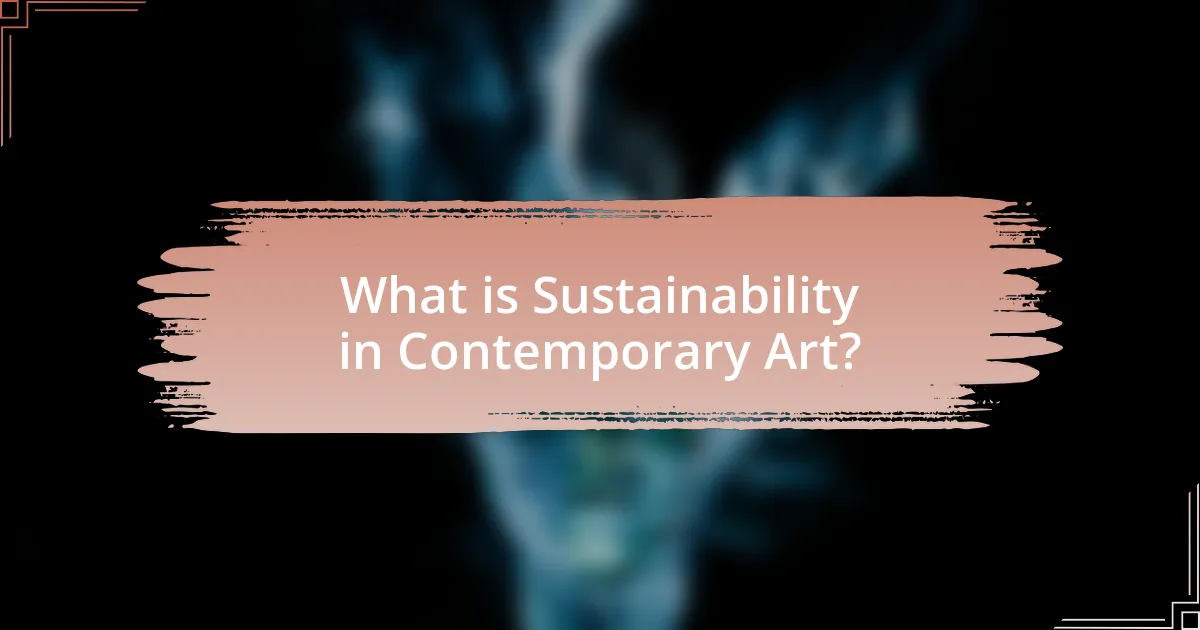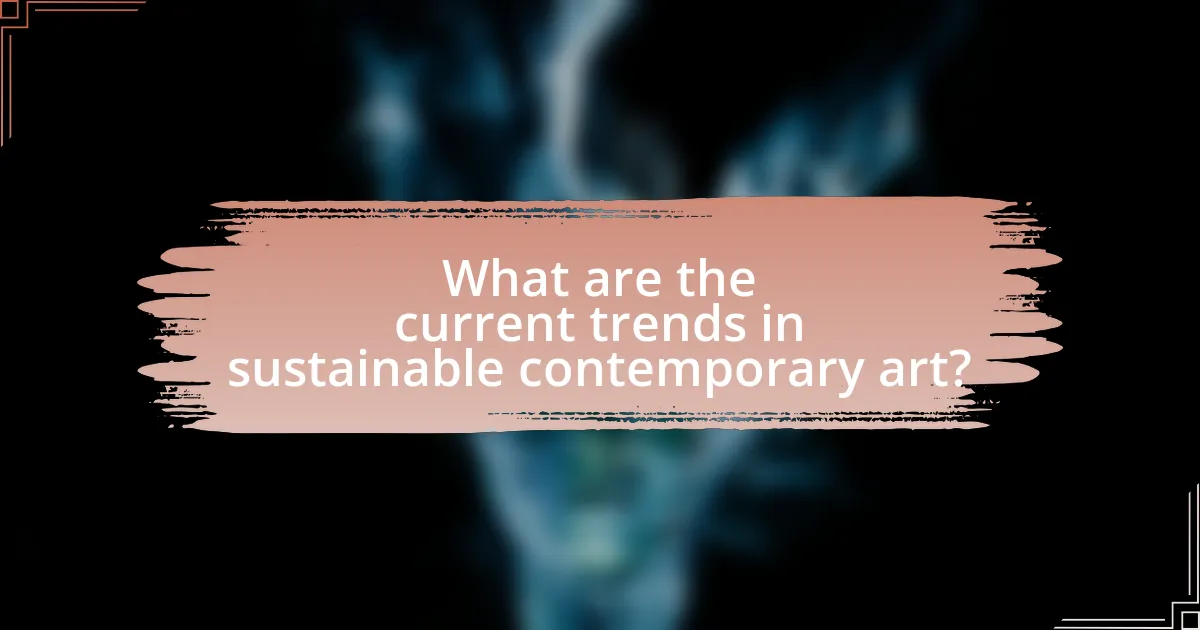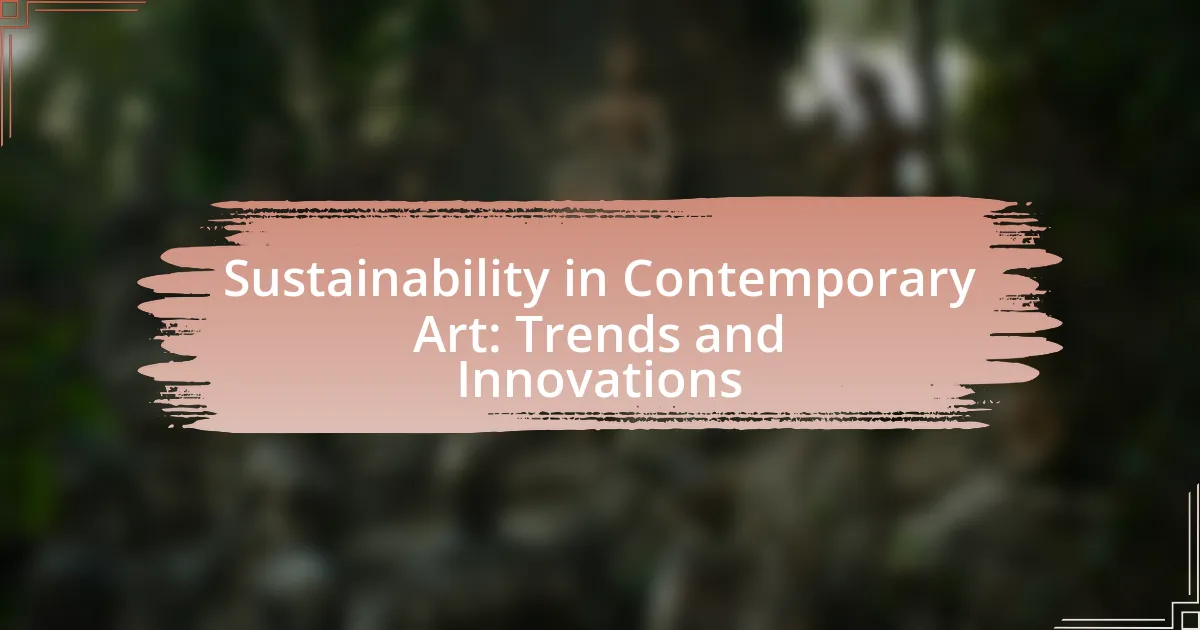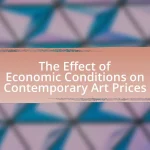Sustainability in contemporary art refers to the integration of environmentally responsible practices and materials in the creation and presentation of artworks. This article explores the definition of sustainability within the art context, key principles such as environmental responsibility and social equity, and how these principles influence artistic practices. It highlights current trends, including the use of eco-friendly materials and community engagement, while addressing the environmental issues contemporary art seeks to tackle. Additionally, the article examines the role of technology in promoting sustainable practices, the challenges artists face, and practical steps they can take to minimize their environmental impact.

What is Sustainability in Contemporary Art?
Sustainability in contemporary art refers to the integration of environmentally responsible practices and materials in the creation and presentation of artworks. This approach emphasizes reducing waste, utilizing sustainable materials, and addressing ecological issues through artistic expression. For instance, artists may use recycled materials or adopt practices that minimize their carbon footprint, thereby contributing to broader environmental goals. The rise of sustainability in contemporary art reflects a growing awareness of climate change and ecological degradation, with many artists actively engaging in dialogues about these critical issues through their work.
How is sustainability defined within the context of contemporary art?
Sustainability in contemporary art is defined as the practice of creating art that minimizes environmental impact and promotes social responsibility. This definition encompasses the use of eco-friendly materials, sustainable production methods, and themes that address ecological and social issues. For instance, artists like Olafur Eliasson incorporate natural elements and renewable resources in their installations, highlighting the relationship between art and the environment. Additionally, the rise of art movements focused on climate change and social justice further illustrates how contemporary art serves as a platform for advocating sustainability.
What are the key principles of sustainability in art?
The key principles of sustainability in art include environmental responsibility, social equity, and economic viability. Environmental responsibility emphasizes the use of eco-friendly materials and processes, reducing waste, and minimizing the carbon footprint of art production. Social equity focuses on inclusivity and community engagement, ensuring that diverse voices are represented and that art serves the public good. Economic viability involves creating sustainable business models that support artists while promoting long-term cultural and environmental health. These principles are supported by initiatives such as the Green Art Lab Alliance, which promotes sustainable practices among artists and institutions, demonstrating the growing commitment to sustainability in the art world.
How does sustainability influence artistic practices?
Sustainability significantly influences artistic practices by prompting artists to adopt eco-friendly materials and methods. This shift is evident as many contemporary artists prioritize sustainable practices to reduce environmental impact, such as using recycled materials or creating works that raise awareness about ecological issues. For instance, the artist Olafur Eliasson incorporates natural elements and sustainable processes in his installations, emphasizing the relationship between art and the environment. Additionally, a study by the University of Edinburgh highlights that 70% of artists surveyed reported integrating sustainability into their work, demonstrating a growing trend towards environmentally conscious artistic expression.
Why is sustainability important in contemporary art?
Sustainability is important in contemporary art because it addresses environmental concerns and promotes responsible practices within the art community. Artists increasingly utilize sustainable materials and methods to reduce their ecological footprint, reflecting a growing awareness of climate change and resource depletion. For instance, the use of recycled materials in installations not only minimizes waste but also engages audiences in discussions about sustainability. Additionally, initiatives like the “Green Art” movement encourage artists to create works that inspire social change and environmental stewardship, demonstrating the role of art in advocating for a sustainable future.
What environmental issues does contemporary art address?
Contemporary art addresses several environmental issues, including climate change, pollution, deforestation, and biodiversity loss. Artists often use their work to raise awareness about the impact of human activity on the planet, highlighting the urgency of these issues. For instance, installations made from recycled materials illustrate the problem of waste and promote sustainability. Additionally, projects that engage with local ecosystems demonstrate the effects of habitat destruction and advocate for conservation efforts. These artistic expressions serve as a powerful medium for environmental advocacy, encouraging public discourse and action on critical ecological challenges.
How can art contribute to social change regarding sustainability?
Art can contribute to social change regarding sustainability by raising awareness, inspiring action, and fostering dialogue about environmental issues. Through various mediums, artists can visually communicate the urgency of sustainability challenges, such as climate change and resource depletion, effectively engaging audiences emotionally and intellectually. For instance, the “Earth Day” art installations have historically mobilized communities to reflect on ecological impacts, demonstrating art’s power to influence public perception and behavior. Furthermore, studies show that art can enhance community involvement in sustainability initiatives, as seen in projects like “The Ocean Cleanup,” where artistic representation of ocean pollution has galvanized support for environmental restoration efforts.

What are the current trends in sustainable contemporary art?
Current trends in sustainable contemporary art include the use of eco-friendly materials, the incorporation of social and environmental themes, and the promotion of community engagement through participatory practices. Artists are increasingly opting for biodegradable, recycled, or upcycled materials to minimize environmental impact, reflecting a growing awareness of ecological issues. For instance, the use of natural pigments and sustainable sourcing of materials has gained popularity, as seen in the works of artists like El Anatsui, who utilizes discarded materials to create large-scale installations. Additionally, many contemporary artists are addressing climate change and social justice in their work, fostering dialogue and awareness around these critical issues. This trend is supported by initiatives such as the “Green Art” movement, which encourages artists to adopt sustainable practices and engage audiences in environmental activism.
How are artists incorporating sustainable materials into their work?
Artists are incorporating sustainable materials into their work by utilizing recycled, upcycled, and natural resources to minimize environmental impact. For instance, many artists are now sourcing materials like reclaimed wood, recycled plastics, and organic pigments, which not only reduce waste but also promote eco-friendly practices. A notable example is the work of artist El Anatsui, who transforms discarded bottle caps into large-scale sculptures, effectively highlighting the potential of waste materials in art. This approach not only fosters creativity but also raises awareness about sustainability issues, demonstrating how art can serve as a platform for environmental advocacy.
What types of sustainable materials are commonly used?
Sustainable materials commonly used include bamboo, recycled metals, organic cotton, and reclaimed wood. Bamboo is favored for its rapid growth and renewability, making it an eco-friendly alternative to traditional timber. Recycled metals, such as aluminum and steel, reduce the need for new mining and processing, thus lowering environmental impact. Organic cotton is cultivated without synthetic pesticides or fertilizers, promoting healthier ecosystems. Reclaimed wood repurposes existing materials, minimizing waste and preserving natural resources. These materials are increasingly adopted in contemporary art to align with sustainability goals and reduce ecological footprints.
How do these materials impact the artistic process?
Materials significantly impact the artistic process by influencing the choice of techniques, themes, and the overall message of the artwork. Sustainable materials, such as recycled plastics or organic pigments, encourage artists to explore environmental themes and promote eco-consciousness in their work. For instance, artists using reclaimed wood not only create unique textures but also convey messages about conservation and resourcefulness. This shift towards sustainability in materials has been documented in various exhibitions and art movements, highlighting the growing importance of ecological considerations in contemporary art practices.
What role does technology play in sustainable art practices?
Technology plays a crucial role in sustainable art practices by enabling artists to create works that minimize environmental impact and utilize eco-friendly materials. For instance, digital tools allow for the design and production of art without the need for traditional, resource-intensive methods, such as painting with toxic solvents or using non-recyclable materials. Additionally, advancements in 3D printing technology facilitate the use of biodegradable materials, reducing waste. Research indicates that artists employing digital mediums can significantly lower their carbon footprint, as seen in projects that utilize virtual reality and augmented reality to create immersive experiences without physical materials. This integration of technology not only promotes sustainability but also expands the possibilities for artistic expression.
How are digital tools being used to promote sustainability in art?
Digital tools are being used to promote sustainability in art by enabling artists to create and share eco-friendly practices and concepts through virtual platforms. These tools facilitate the use of digital media, such as 3D modeling and virtual reality, which reduce the need for physical materials and waste. For instance, artists can design and exhibit their work online, minimizing the carbon footprint associated with traditional gallery shows. Additionally, software applications allow for the simulation of sustainable materials and processes, helping artists make informed choices that align with environmental goals. This shift towards digital mediums not only enhances accessibility but also encourages collaboration among artists focused on sustainability, as seen in initiatives like the “EcoArt Network,” which connects creators dedicated to ecological themes.
What innovations in technology are shaping sustainable art?
Innovations in technology shaping sustainable art include the use of biodegradable materials, digital fabrication techniques, and renewable energy sources. Biodegradable materials, such as mycelium and plant-based resins, allow artists to create works that decompose naturally, reducing environmental impact. Digital fabrication techniques, like 3D printing and laser cutting, enable precise production with minimal waste, as they can utilize recycled materials and optimize designs for efficiency. Additionally, renewable energy sources, such as solar panels, are increasingly integrated into art installations, allowing artists to power their work sustainably. These technological advancements not only enhance the creative process but also promote environmental responsibility within the art community.

What innovations are emerging in the field of sustainable contemporary art?
Innovations in sustainable contemporary art include the use of eco-friendly materials, digital art forms that reduce physical waste, and community-based projects that promote environmental awareness. Artists are increasingly incorporating recycled materials into their works, such as plastic waste and organic substances, to minimize their ecological footprint. Additionally, the rise of digital art allows for the creation of artworks without the need for traditional resources, thus reducing material consumption. Community engagement initiatives, such as collaborative installations and public art projects, foster a collective consciousness about sustainability and encourage local participation in environmental stewardship. These trends reflect a growing commitment within the art community to address climate change and promote sustainability through creative expression.
How are collaborative projects advancing sustainability in art?
Collaborative projects are advancing sustainability in art by fostering interdisciplinary partnerships that integrate ecological practices into artistic processes. These collaborations often involve artists, scientists, and community members working together to address environmental issues through creative expression. For instance, initiatives like the “EcoArt Network” promote projects that utilize recycled materials and sustainable methods, demonstrating a commitment to reducing waste and environmental impact. Additionally, research published in the “Journal of Art and Ecology” highlights how collaborative art projects can raise awareness about climate change and inspire community action, effectively merging art with activism for sustainability.
What are some notable examples of collaborative sustainable art projects?
Notable examples of collaborative sustainable art projects include “The Ocean Cleanup,” which involves artists and engineers working together to develop technology for removing plastic from oceans, and “The Greenhouse Project,” where artists collaborate with local communities to create urban gardens that promote biodiversity and sustainability. These projects exemplify the intersection of art and environmental activism, demonstrating how collaborative efforts can address pressing ecological issues. The Ocean Cleanup has successfully deployed systems that have collected thousands of kilograms of plastic waste, while The Greenhouse Project has transformed urban spaces into sustainable ecosystems, showcasing the tangible impact of these artistic collaborations.
How do these collaborations enhance community engagement?
Collaborations enhance community engagement by fostering inclusive participation and shared ownership of artistic projects. These partnerships often involve local artists, organizations, and community members, which creates a sense of belonging and encourages diverse voices to contribute. For instance, community-based art initiatives have been shown to increase social cohesion and civic pride, as evidenced by studies indicating that neighborhoods with active art collaborations report higher levels of community satisfaction and involvement. Such collaborations not only amplify the reach of artistic expressions but also empower communities to address local issues through creative solutions, thereby reinforcing the connection between art and social sustainability.
What are the challenges faced by artists pursuing sustainability?
Artists pursuing sustainability face significant challenges, including limited access to eco-friendly materials, financial constraints, and a lack of awareness or support from the art market. The availability of sustainable materials is often restricted, making it difficult for artists to create works that align with their environmental values. Financially, sustainable practices can be more expensive, deterring artists from adopting them. Additionally, the art market frequently prioritizes traditional methods and materials, which can marginalize artists who wish to innovate sustainably. These challenges are supported by studies indicating that many artists struggle to balance their creative vision with the practicalities of sustainable production.
What financial barriers exist for sustainable art practices?
Financial barriers for sustainable art practices include high initial costs, limited funding opportunities, and market demand challenges. The high initial costs arise from the need for eco-friendly materials and sustainable production methods, which can be more expensive than traditional options. Limited funding opportunities exist as many grants and sponsorships prioritize conventional art forms over sustainable initiatives, making it difficult for artists to secure financial support. Additionally, market demand challenges occur when consumers are less willing to pay a premium for sustainable art, impacting artists’ ability to sustain their practices financially. These barriers collectively hinder the growth and viability of sustainable art practices in the contemporary art landscape.
How do artists overcome these challenges?
Artists overcome challenges related to sustainability in contemporary art by adopting innovative practices and materials that minimize environmental impact. For instance, many artists utilize recycled or upcycled materials, which not only reduce waste but also promote a circular economy. Additionally, artists often engage in collaborative projects that emphasize community involvement and awareness, thereby fostering a collective approach to sustainability. Research indicates that artists who incorporate sustainable practices can significantly influence public perception and behavior regarding environmental issues, as seen in initiatives like the “EcoArt Network,” which connects artists focused on ecological themes.
What practical steps can artists take to promote sustainability in their work?
Artists can promote sustainability in their work by utilizing eco-friendly materials and practices. This includes sourcing sustainable or recycled materials, such as organic paints, reclaimed wood, or biodegradable substances, which reduces environmental impact. Additionally, artists can adopt energy-efficient methods in their studios, such as using LED lighting and renewable energy sources, which further minimizes their carbon footprint.
Research indicates that the art industry contributes significantly to waste and pollution; therefore, implementing these practices can lead to a more sustainable creative process. For instance, a study by the Arts Council England highlights that adopting sustainable practices can not only benefit the environment but also enhance the artist’s reputation and appeal to environmentally conscious audiences.
How can artists source sustainable materials effectively?
Artists can source sustainable materials effectively by establishing relationships with local suppliers who specialize in eco-friendly products. This approach allows artists to access a variety of sustainable options, such as organic paints, recycled papers, and biodegradable mediums. Research indicates that sourcing locally not only reduces carbon footprints associated with transportation but also supports local economies, fostering a community-oriented approach to sustainability. For instance, a study by the Journal of Cleaner Production highlights that local sourcing can decrease environmental impact by up to 30% compared to sourcing from distant suppliers. Additionally, artists can explore online platforms dedicated to sustainable art supplies, which often provide detailed information about the environmental impact of their products, enabling informed choices.
What best practices should artists follow to minimize their environmental impact?
Artists should adopt sustainable practices such as using eco-friendly materials, reducing waste, and implementing energy-efficient processes to minimize their environmental impact. Utilizing non-toxic paints, recycled materials, and sustainable sourcing for supplies significantly lowers the carbon footprint associated with art creation. For instance, a study published in the Journal of Cleaner Production highlights that using recycled materials can reduce resource consumption by up to 50%. Additionally, artists can minimize waste by repurposing materials and employing digital tools to reduce physical outputs. Implementing energy-efficient lighting and equipment in studios further contributes to sustainability, as energy-efficient technologies can decrease energy use by 30-50%. By integrating these practices, artists can effectively contribute to environmental conservation while maintaining their creative expression.


